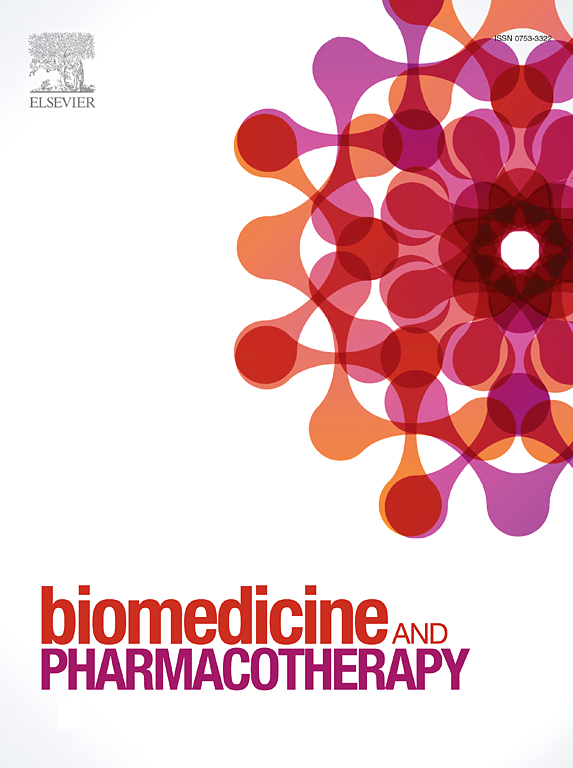佛手柑多酚部分(BPF)在masld诱导的HFpEF中的作用:通过靶向慢性低度炎症减轻舒张功能障碍
IF 6.9
2区 医学
Q1 MEDICINE, RESEARCH & EXPERIMENTAL
引用次数: 0
摘要
目的:代谢功能障碍相关脂肪变性肝病(MASLD)是一个独立的危险因素,也是保留射血分数(HFpEF)心力衰竭病理生理学的关键因素,强调了早期发现和干预的迫切需要。生物成像技术为监测疾病进展提供了有价值的形态学和功能见解,并指导针对这些疾病相关的早期代谢和炎症机制的治疗策略。与传统的药理学疗法一样,营养保健品是一级预防的一个很有前途的候选药物。在这里,我们研究了BPF在缓解masld相关的HFpEF中的潜在作用。方法与结果将DIAMOND小白鼠随机分为两组,一组喂食含自来水的鼠粮,另一组喂食含糖水的高脂肪鼠粮。从第16周开始,将小鼠进一步细分,并给药或BPF(50 mg/kg/day po),直到第30周。在基线和第30周进行超声心动图分析。通过相关和回归分析来评估促炎介质在舒张功能障碍发生中的作用。补充BPF改善了舒张功能,改善了E/A比,以及左室舒张和收缩组织应变功能障碍和非同步化。这些影响是由与HFpEF表型直接相关的慢性低级别炎症介质诱导的。结论BPF可改善舒张功能障碍,减轻慢性低度炎症。由于这种炎症状态是HFpEF的关键易感因素,BPF补充成为一种潜在的治疗策略,可以缓解早期masld相关的炎症和导致心功能障碍的病理变化。本文章由计算机程序翻译,如有差异,请以英文原文为准。
The role of Bergamot Polyphenolic Fraction (BPF) in MASLD-Induced HFpEF: Mitigate diastolic dysfunction by targeting chronic low-grade inflammation
Aims
Metabolic dysfunction-associated steatotic liver disease (MASLD) is an independent risk factor and a key contributor to the pathophysiology of heart failure with preserved ejection fraction (HFpEF), highlighting the urgent need for early detection and intervention. Bioimaging techniques provide valuable morphological and functional insights to monitor the disease progression and guide therapeutic strategies targeting early metabolic and inflammatory mechanisms that link these conditions. Alongside traditional pharmacological therapies, nutraceuticals are a promising candidate for primary prevention. Here, we investigated the potential role of BPF in mitigating MASLD-related HFpEF.
Methods and results
Male DIAMOND mice were randomly assigned to receive either a chow diet with tap water or a high-fat diet with sugar water. Starting at week 16, mice were further subdivided and treated with either vehicle or BPF (50 mg/kg/day po), until week 30. Echocardiographic analysis was conducted at the baseline and at week 30. Correlation and regression analyses were performed to assess the role of pro-inflammatory mediators in the onset of diastolic dysfunction. BPF supplementation ameliorated diastolic function, improving the E/A ratio, as well as left ventricular diastolic and systolic tissue strain dysfunction and dyssynchrony. These effects are induced by chronic low-grade inflammatory mediators straightly associated with the HFpEF phenotype.
Conclusion
Our results demonstrated that BPF improved diastolic dysfunction and reduced chronic low-grade inflammation. Since this inflammatory state is a key predisposing factor for the HFpEF, BPF supplementation emerged as a potential therapeutic strategy to alleviate early MASLD-related inflammation and pathological changes that contribute to the onset of cardiac dysfunction.
求助全文
通过发布文献求助,成功后即可免费获取论文全文。
去求助
来源期刊
CiteScore
11.90
自引率
2.70%
发文量
1621
审稿时长
48 days
期刊介绍:
Biomedicine & Pharmacotherapy stands as a multidisciplinary journal, presenting a spectrum of original research reports, reviews, and communications in the realms of clinical and basic medicine, as well as pharmacology. The journal spans various fields, including Cancer, Nutriceutics, Neurodegenerative, Cardiac, and Infectious Diseases.

 求助内容:
求助内容: 应助结果提醒方式:
应助结果提醒方式:


